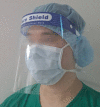Risk of Bacterial Exposure to the Anesthesiologist's Face During Intubation and Extubation
- PMID: 37138835
- PMCID: PMC10149769
- DOI: 10.2147/IDR.S405537
Risk of Bacterial Exposure to the Anesthesiologist's Face During Intubation and Extubation
Abstract
Introduction: Anesthesiologists are exposed to the risk of infection from various secretions or droplets from the respiratory tract of patients. We aimed to determine bacterial exposure to anesthesiologists' faces during endotracheal intubation and extubation.
Methods: Six resident anesthesiologists performed 66 intubation and 66 extubation procedures in patients undergoing elective otorhinolaryngology surgeries. Sampling was performed by swabbing the face shields twice in an overlapping slalom pattern, before and after each procedure. Samples for pre-intubation and pre-extubation were collected immediately after wearing the face shield at the time of anesthesia induction and at the end of the surgery, respectively. Post-intubation samples were collected after the injection of anesthetic drugs, positive pressure mask ventilation, endotracheal intubation, and confirmation of intubation success. Post-extubation samples were collected after endotracheal tube suction, oral suction, extubation, and confirmation of spontaneous breathing and stable vital signs. All swabs were cultured for 48 h, and bacterial growth was confirmed by colony forming unit (CFU) count.
Results: There was no bacterial growth in either pre- or post-intubation bacterial cultures. In contrast, while there was no bacterial growth in pre-extubation samples, 15.2% of post-extubation samples were CFU+ (0/66 [0%] vs 10/66 [15.2%], p=0.001). All the CFU+ samples belonged to 47 patients with post-extubation coughing, and the CFU count was correlated with the number of coughing episodes during the process of extubation (P < 0.01, correlation coefficient= 0.403).
Conclusion: The current study shows the actual chance of bacterial exposure to the anesthesiologist's face during the patient awakening process after general anesthesia. Given the correlation between the CFU count and the number of coughing episodes, we recommend anesthesiologists to use appropriate facial protection equipment during this procedure.
Keywords: bacterial exposure; cough; extubation; face shield; intubation.
© 2023 Song et al.
Conflict of interest statement
The authors declare that they have no competing interests.
Similar articles
-
Effects of the anesthesiologist's experience on postoperative hoarseness after double-lumen endotracheal tube intubation: a single-center propensity score-matched analysis.BMC Anesthesiol. 2020 Nov 5;20(1):278. doi: 10.1186/s12871-020-01198-1. BMC Anesthesiol. 2020. PMID: 33153457 Free PMC article.
-
Comparison of Normal Saline and Alkalinized 2% Lignocaine to Reduce Emergence Phenomenon and Post-Intubation Morbidities: A Prospective, Double-Blind, Randomized Study.Cureus. 2023 Jan 18;15(1):e33910. doi: 10.7759/cureus.33910. eCollection 2023 Jan. Cureus. 2023. PMID: 36819305 Free PMC article.
-
Retrograde Lidocaine Spray for Awake Extubation in Pediatric ENT Surgery: Optimizing Tonsillectomy and Adenoidectomy Outcomes.Cureus. 2024 Aug 31;16(8):e68293. doi: 10.7759/cureus.68293. eCollection 2024 Aug. Cureus. 2024. PMID: 39350856 Free PMC article.
-
Extubation and the Risks of Coughing and Laryngospasm in the Era of Coronavirus Disease-19 (COVID-19).Cureus. 2020 May 19;12(5):e8196. doi: 10.7759/cureus.8196. Cureus. 2020. PMID: 32440387 Free PMC article. Review.
-
Body Map of Droplet Distributions During Oropharyngeal Suction to Protect Health Care Workers From Airborne Diseases.J Perianesth Nurs. 2023 Apr;38(2):180-185. doi: 10.1016/j.jopan.2022.05.087. Epub 2022 Jun 10. J Perianesth Nurs. 2023. PMID: 36229328 Free PMC article. Review.
References
LinkOut - more resources
Full Text Sources


